Are you ready to take your mobile app to the next level?
Today, we’re diving into the exciting world of mobile app gamification – a powerful strategy that can transform your app from a mere tool to an addictive experience that keeps users coming back for more.
Imagine your app as a game where users earn rewards, unlock achievements, and compete with friends.
Sounds fun, right?
That’s precisely what gamification aims to achieve.
By incorporating game-like elements into your app, you can boost user engagement, increase retention rates, and drive app growth like never before.
In this blog post, we’ll explore the ins and outs of gamification in mobile apps.
We’ll uncover the secrets behind the best gamified apps, discuss the benefits of gamification, and provide you with actionable strategies to gamify your own app.
So, buckle up and get ready to embark on a thrilling journey into the world of mobile app gamification.
What is Gamification?
Picture this: You’re using a fitness app, and suddenly, a virtual badge pops up on your screen.
“Congratulations! You’ve achieved your daily step goal!”
You feel a sense of accomplishment and motivation to keep going. That, my friend, is gamification in action.
Gamification in mobile apps is the art of integrating game-like elements and mechanics into non-game contexts.
It’s all about creating engaging, rewarding experiences that keep users hooked.
By tapping into our innate desire for competition, achievement, and social interaction, gamification transforms mundane tasks into exciting challenges.
From leaderboards and progress bars to virtual currencies and avatars, gamification techniques for apps take many forms.
The key is to select the right gamification trends in mobile apps for your app design, based on your target audience and desired outcomes.
When done right, mobile app gamification can work wonders for your app’s user engagement and retention rates, ultimately contributing to your app’s success.
Gamification Mechanics: Turning Players into Engaged Users
At the heart of any successful gamified mobile app lies a set of well-designed gamification mechanics.
These are the essential components that make up the gamification system, driving user engagement and motivation.
To create an engaging gamified experience, it’s crucial to consider the app tech stack and ensure seamless integration with the app architecture.
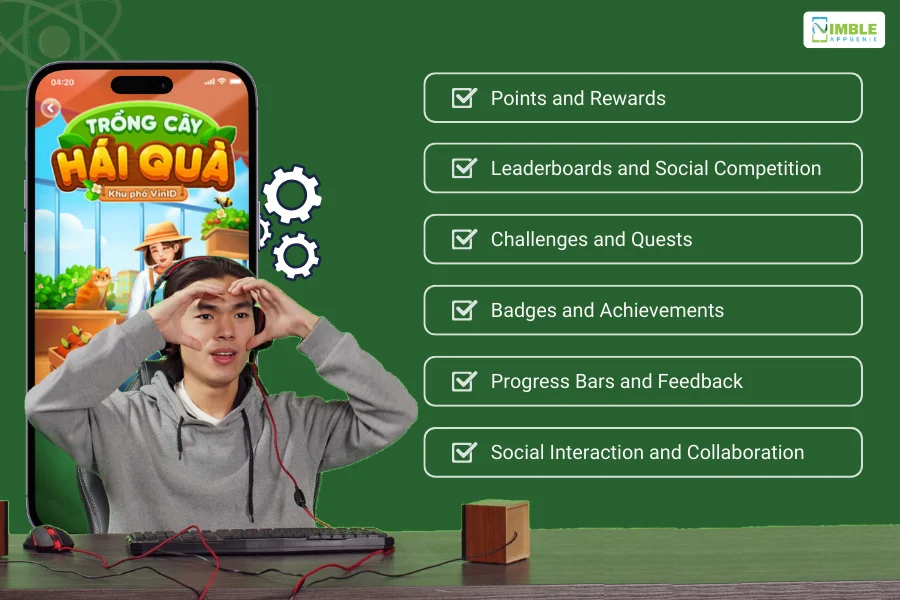
Let’s take a closer look at some of the most effective gamification techniques for apps:
1. Points and Rewards
One of the most common gamification examples in mobile apps is the use of points and rewards.
Users earn points for completing specific actions within the app, such as making a purchase, sharing content, or logging in daily.
These points can then be redeemed for rewards, discounts, or special features.
This mechanic taps into our innate desire for achievement and recognition, encouraging users to keep engaging with the app.
2. Leaderboards and Social Competition
Leaderboards are a powerful way to foster social competition and engagement, making them a popular choice in gamification trends in mobile apps.
By displaying user rankings based on their achievements or progress, you tap into people’s natural competitive spirit.
Users will strive to climb the ranks and outperform their friends, creating a sense of community and driving app engagement.
Leaderboards can be based on various metrics, such as points earned, levels completed, or challenges won.
3. Challenges and Quests
Presenting users with specific goals and challenges is another effective gamification mechanic for apps.
By setting clear objectives and providing a sense of purpose, you encourage users to invest more time and effort into your app.
Challenges can range from simple tasks, like completing a profile or inviting friends to more complex quests that require multiple steps and rewards.
As users progress through these challenges, they feel a sense of accomplishment and become more engaged with your app.
4. Badges and Achievements
Badges and achievements are visual representations of a user’s progress and accomplishments within the app.
They serve as virtual trophies that users can collect and display, providing a sense of pride and motivation.
Badges can be earned for various milestones, such as reaching a certain level, completing a set of challenges, or using the app consistently over time.
By offering a diverse range of badges, you cater to different user preferences and keep them engaged.
5. Progress Bars and Feedback
Progress bars and feedback mechanics provide users with a clear sense of their advancement within the app.
By visually representing their progress towards a goal or milestone, you create a sense of momentum and encourage users to keep going.
Progress bars can be used for individual tasks, overall app usage, or specific challenges.
Providing instant feedback, such as congratulatory messages or animations, reinforces positive behaviors and keeps users motivated.
6. Social Interaction and Collaboration
Gamification mechanics that foster social interaction and collaboration can greatly enhance user engagement.
By allowing users to connect with friends, join teams, or compete against each other, you create a sense of community and belonging.
Social features like chat, gifting, or collaborative challenges encourage users to interact with each other within the app, increasing retention and loyalty.
When designing your gamification system, it’s essential to choose the right combination of mechanics that align with your app’s core functionality and user goals. By carefully selecting and implementing these components, you can create an engaging and addictive experience that keeps users coming back for more.
Why Care About Gamification in Mobile Apps?
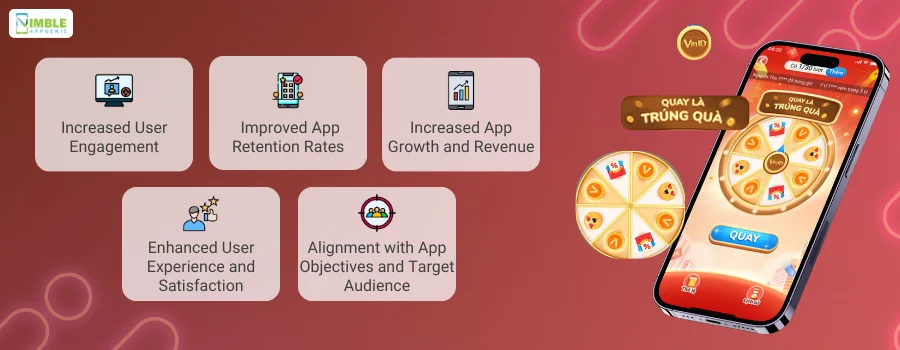
In today’s competitive app market, simply having a functional app is not enough.
With millions of apps vying for users’ attention, it’s crucial to find ways to stand out and keep users engaged.
This is where the benefits of gamification in mobile apps come into play.
♦ Increased User Engagement
One of the key mobile app gamification benefits is increased user engagement.
By incorporating gamified mobile app features, you can create a more enjoyable and rewarding experience that keeps users coming back for more.
When users are motivated by rewards, challenges, and social interactions, they spend more time using your app, leading to higher levels of engagement and loyalty.
♦ Improved App Retention Rates
Gamification can significantly improve app retention rates.
In a world where the average app loses 77% of its users within the first three days, gamification strategies can be a game-changer.
By providing users with a sense of progression, achievement, and community, gamification gives them a reason to keep using your app over time, helping combat app abandonment and foster long-term retention.
♦ Increased App Growth and Revenue
Gamification also has the potential to drive app growth and revenue.
By incentivizing users to complete specific actions, such as making in-app purchases, sharing content, or referring to friends, gamification can directly impact your app’s bottom line.
Gamified app features can encourage users to explore more of your app’s functionalities, leading to increased usage and monetization opportunities.
♦ Enhanced User Experience and Satisfaction
Gamification in mobile apps can enhance the overall user experience and satisfaction.
By incorporating gamification elements into your app design, you create a more engaging and interactive environment.
Users feel a sense of accomplishment and progress as they unlock new levels, earn badges, and compete with friends, leading to higher levels of satisfaction and loyalty.
♦ Alignment with App Objectives and Target Audience
The success of gamification in mobile apps depends on careful planning and execution.
It’s essential to align your gamification strategies with your app’s core objectives, target audience, and app tech stack.
By doing so, you can create a seamless and meaningful gamification experience that enhances your app’s value proposition.
In conclusion, the benefits of gamification in mobile apps are clear. From boosting user engagement and retention to driving app growth and revenue, gamification has the potential to revolutionize the way users interact with your app. By incorporating well-designed gamification mechanics and aligning them with your app’s goals, you can create a truly addictive and rewarding experience that sets your app apart in the competitive app market.
Popular Apps and Their Attempts At Gamification
Gamification has taken the mobile app world by storm, with numerous apps successfully implementing gamification techniques to engage and retain users.
Take a look at some of the best gamified apps and how they’ve incorporated gamification elements into their user experience.
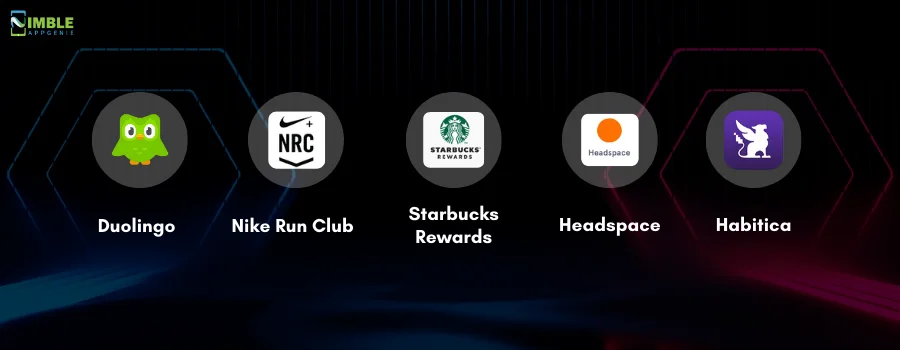
► Duolingo
If you are planning to develop an app like Duolingo, here’s what you need to know.
Language Learning Made Fun Duolingo, a popular language learning app, has mastered the art of gamification in mobile apps.
The app uses a combination of points, leaderboards, and achievements to keep users motivated and engaged.
As users complete lessons and make progress, they earn experience points (XP) and level up, unlocking new content and features.
The app also employs daily streaks and challenges to encourage consistent usage.
► Nike Run Club
Turning Fitness into a Game Nike Run Club is a prime example of gamification in mobile apps.
The app gamifies the running experience by allowing users to set goals, track their progress, and compete with friends.
Users can earn achievements, join challenges, and even compete in virtual races.
The app’s leaderboards and social features create a sense of community and motivation, encouraging users to push themselves further.
► Starbucks Rewards
Loyalty Program Meets Gamification Starbucks Rewards is a testament to the power of gamification in mobile apps.
The app’s loyalty program is designed like a game where users earn stars for every purchase they make.
As they accumulate stars, they level up and unlock rewards, such as free drinks and food items.
The app also employs challenges and bonus star opportunities to keep users engaged and coming back for more.
► Headspace
Meditation Meets Gamification Headspace, a popular meditation app, has incorporated gamification elements to make mindfulness more engaging.
The app uses a progress tracking system, where users can see their meditation streaks and earn rewards for consistent practice.
Users can also unlock new levels and content as they complete meditation packs and challenges.
The app’s gamification features help users stay motivated and build regular meditation habits. And that’s why so many businesses are attempting to develop an app like headspace.
► Habitica
Gamifying Productivity and Self-Improvement Habitica is a unique app that gamifies task management and personal growth.
Users create avatars and complete real-life tasks and habits to earn experience points, gold, and other rewards.
As they progress, they can level up their characters, unlock new features, and even battle monsters with friends.
Habitica successfully transforms mundane tasks into a fun and rewarding experience.
These are just a few examples of popular apps and their attempts at gamification. By studying these best gamified apps, you can gain valuable insights into how to effectively incorporate gamification techniques into your own app design.
How To “Gamify” Your Mobile App?
Now that we’ve explored the benefits of gamification in mobile apps and seen some successful examples, you might be wondering how to actually implement gamification in your own app.
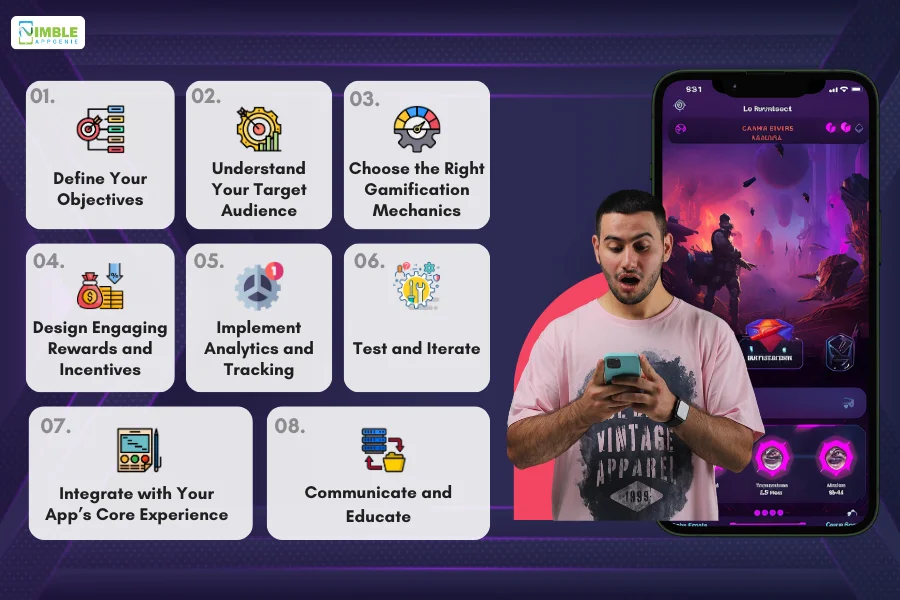
Here’s a detailed, step-by-step guide on how to gamify an app:
Step 1: Define Your Objectives
The first step in implementing gamification is to identify the specific goals you want to achieve.
Are you looking to increase user engagement, improve retention, or drive specific user actions?
Clearly define your objectives and align them with your app’s overall strategy and value proposition. Set measurable and achievable targets to track the success of your gamification initiatives.
Step 2: Understand Your Target Audience
To create an effective gamification strategy, you need to have a deep understanding of your target audience.
And that’s where app’s market research comes in.
Conduct thorough user research to gain insights into your users’ demographics, preferences, and motivations.
Analyze user behavior within your app to identify patterns and opportunities for gamification.
Create user personas to better understand the different segments of your audience and tailor your gamification techniques accordingly.
Step 3: Choose the Right Gamification Mechanics
Once you have a clear understanding of your objectives and target audience, it’s time to choose the right gamification mechanics.
Consider which mechanics align best with your app’s core functionality and user journey.
Some popular options include:
- Points: Reward users for completing specific actions or achieving milestones within your app.
- Badges: Recognize user accomplishments and progress with visual markers of achievement.
- Leaderboards: Foster competition and social engagement by displaying user rankings based on performance.
- Challenges: Present users with specific goals or missions to complete, offering rewards upon completion.
- Progress Bars: Visually represent user advancement towards a goal or milestone, encouraging continued engagement.
Remember, the goal is to enhance the user experience, not disrupt it. Choose mechanics that seamlessly integrate with your app’s existing features and app design.
Step 4: Design Engaging Rewards and Incentives
Rewards and incentives are a crucial aspect of gamification.
They provide motivation and keep users engaged. When designing rewards, consider both intrinsic and extrinsic motivators.
Intrinsic rewards, such as a sense of accomplishment or personal growth, can be just as powerful as extrinsic rewards like discounts or exclusive content.
Ensure that your rewards are meaningful, achievable, and aligned with your app’s value proposition.
Consider using a variety of reward types to cater to different user preferences.
Step 5: Implement Analytics and Tracking
To measure the success of your gamification strategy, it’s essential to implement robust analytics and tracking systems.
Monitor key user engagement metrics, such as time spent in the app, number of sessions, and completion rates for gamified actions.
Use this data to identify areas for improvement and optimize your gamification mechanics over time.
Set up dashboards and reporting tools to easily visualize and analyze your gamification data.
Step 6: Test and Iterate
Gamification is an iterative process that requires continuous testing and refinement.
Conduct A/B tests to compare different gamification elements and see which ones resonate best with your users.
Gather user feedback through surveys, interviews, or in-app feedback mechanisms to gain insights into user preferences and pain points.
Be open to making adjustments and improvements based on data-driven insights and user feedback.
Step 7: Integrate with Your App’s Core Experience
Successful gamification should feel seamless and integrated with your app’s core experience.
Ensure that your app tech stack and app architecture can support the integration of gamification mechanics.
Work closely with your app development team to weave gamification elements into the user journey in a way that enhances the overall experience.
Avoid tacking on gamification as an afterthought; instead, make it an integral part of your app’s design and functionality.
Step 8: Communicate and Educate
When introducing gamification to your app, it’s crucial to communicate and educate your users about the new features.
Provide clear instructions, tutorials, and onboarding experiences to guide users through the gamified elements of your app.
Celebrate user achievements and milestones through in-app notifications, emails, or social media shout-outs.
Foster a sense of community and encouragement by highlighting user success stories and facilitating social interactions within your app.
By following these detailed steps and incorporating the right gamification techniques, you can transform your app into an engaging and addictive experience. Remember to tailor your gamification strategy to your specific app, audience, and objectives. Continuously monitor and optimize your gamification mechanics based on user feedback and data insights.
The Cost of Gamification
Implementing gamification in your mobile app can significantly enhance user engagement and retention, but it’s important to consider the costs associated with the process.
While the benefits of gamification in mobile apps are clear, understanding the investment required can help you plan your app development budget and resources effectively.
The total cost of implementing gamification in a mobile app can vary greatly depending on factors such as the complexity of the gamification system, the size of the development team, and the specific technologies and services required.
On average, the cost of gamifying an app can range from $50,000 to $200,000 or more.
Here’s a breakdown of the typical cost distribution for gamifying a mobile app:
| Cost Component | Percentage of Total Cost |
| Design and Development | 60-70% |
| Technology and Infrastructure | 15-20% |
| Maintenance and Optimization | 10-15% |
| Marketing and Promotion | 5-10% |
Remember, these are rough estimates, and the actual cost distribution may vary depending on your specific app requirements and market conditions.
It’s essential to work closely with your app development team and carefully plan your gamification budget to ensure a successful implementation while optimizing costs.
By understanding the costs associated with gamifying your mobile app, you can make informed decisions and allocate resources effectively to maximize the benefits of gamification in mobile apps while staying within your budget constraints.
Nimble AppGenie: Your Partner in Mobile App Innovation
Implementing gamification in your mobile app can be a complex and resource-intensive process.
It requires expertise in app design, app development, and gamification strategies. That’s where Nimble AppGenie comes in – as your trusted partner in mobile app innovation.
Nimble AppGenie is a leading mobile app development company that specializes in creating engaging and addictive app experiences through the power of gamification.
With a team of skilled game designers, UI/UX experts, and experienced developers, Nimble AppGenie has helped numerous businesses transform their mobile apps into thriving, gamified platforms.
Conclusion
Gamification has emerged as a powerful tool for driving user engagement, retention, and growth in mobile apps. By incorporating game-like elements and mechanics, you can transform your app into an addictive and rewarding experience that keeps users coming back for more. From understanding your target audience and defining clear objectives to choosing the right gamification techniques and continuously optimizing your approach, gamifying your mobile app requires careful planning and execution.
FAQs

Niketan Sharma is the CTO of Nimble AppGenie, a prominent website and mobile app development company in the USA that is delivering excellence with a commitment to boosting business growth & maximizing customer satisfaction. He is a highly motivated individual who helps SMEs and startups grow in this dynamic market with the latest technology and innovation.
Table of Contents




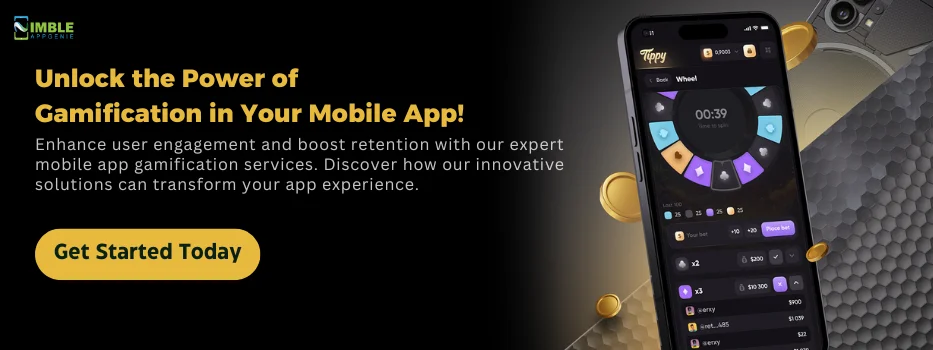
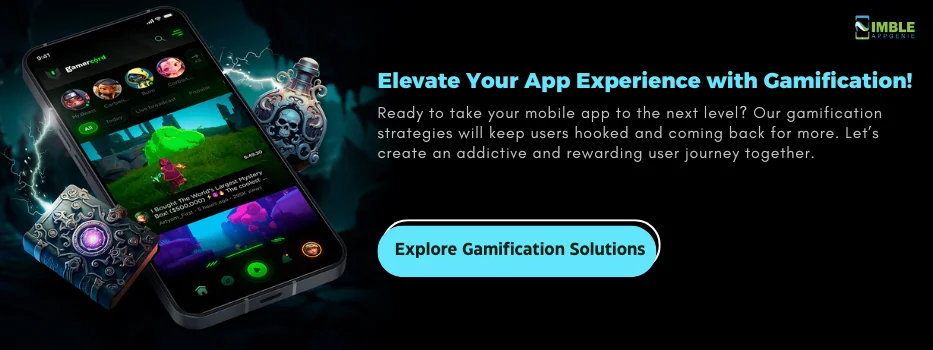
No Comments
Comments are closed.